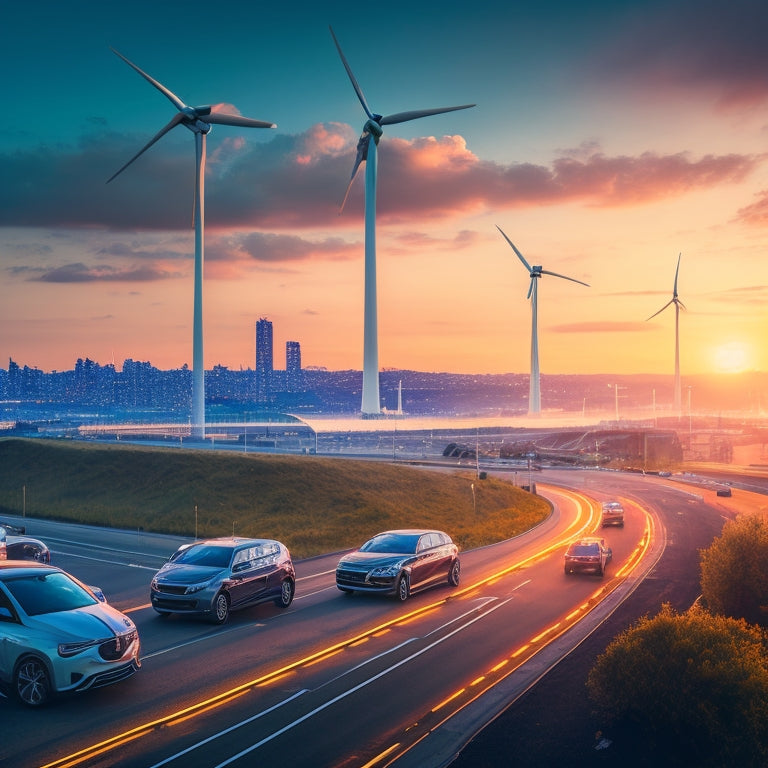
Rev Up Your Knowledge: Electric Vehicle Essentials
Share
Electric vehicles depend on a complex ecosystem of charging infrastructure, energy efficiency standards, and informed purchasing decisions. Understanding the fundamentals of EV technology is essential for successfully maneuvering the market with confidence. There are three main charging methods: Level 1, Level 2, and Quick Charging (Level 3), each with varying speeds and requirements. To find charging stations, drivers can use apps like PlugShare and ChargeHub or locate them in metropolitan areas, such as malls and grocery stores. The MPGe standard measures EV energy efficiency, enabling informed purchasing decisions. Understanding these essentials is key to tapping into the full potential of electric vehicles, and there's more to discover.
Key Takeaways
• Understanding Level 1, Level 2, and Quick Charging methods helps optimize EV charging and plan trips efficiently.
• Finding charging stations is easier with apps like PlugShare and ChargeHub, and online locators like EVgo and ChargePoint.
• The MPGe standard allows for comparison of EV models' energy efficiency, range, and cost savings.
• Quick Charging is ideal for long trips or last-minute charging needs, and strategically located for convenience.
• Practicing public charging etiquette, such as unplugging when fully charged, ensures a seamless experience for all EV owners.
Charging Methods Explained
Electric vehicle owners typically have three primary charging methods to choose from, each with distinct advantages and limitations: Level 1, Level 2, and Quick Charging.
Level 1 charging utilizes a standard household outlet, making it convenient for home use, but it's the slowest method due to electric vehicles' large battery capacity.
Level 2 charging is faster, often available in commercial parking lots and designated EV spaces, and may require a paid subscription.
Quick Charging, also known as Level 3, is the fastest, ideal for long trips or last-minute needs. Understanding the benefits and limitations of each method allows electric vehicle owners to optimize their charging experience.
Level 1 vs Level 2 charging methods offer varying speeds, while Quick Charging benefits include rapid recharging and convenience.
Finding Charging Stations
Numerous charging stations are emerging in large metropolitan areas, with many major malls, grocery stores, and office buildings offering dedicated EV parking spaces.
To find these stations, drivers can utilize charging station apps, such as PlugShare or ChargeHub, which provide real-time information on station availability and location.
It's essential to practice public charging etiquette, such as unplugging when fully charged and respecting time limits, to ensure a seamless experience for all EV owners.
For added convenience, many charging networks, like EVgo and ChargePoint, offer online locators and mobile apps to help drivers find stations near their location.
EV Efficiency and Measurement
Measuring the efficiency of electric vehicles is essential for consumers, and the MPGe standard provides a useful benchmark for comparing the energy efficiency of various EV models.
The MPGe measurement allows for an apples-to-apples comparison of electric vehicle range and efficiency, enabling consumers to make informed purchasing decisions.
When evaluating EVs, consider the MPGe rating, which represents the distance an EV can travel on the energy equivalent of one gallon of gasoline. A higher MPGe rating indicates better efficiency and a longer electric vehicle range.
For example, an EV with a 120 MPGe rating is more efficient than one with a 90 MPGe rating, resulting in cost savings and reduced environmental impact.
Frequently Asked Questions
Can I Charge My Electric Vehicle in the Rain or Wet Conditions?
'Electric vehicles are designed with water resistance in mind, guaranteeing safe charging in rainy or wet conditions. Manufacturers incorporate protective measures, such as waterproof connectors and sealed charging ports, to prevent electrical shock and ensure charging safety.'
How Often Should I Update My Electric Vehicle's Software?
Frequently updating your electric vehicle's software is essential to avoid cybersecurity risks and guarantee peak performance, as outdated software can jeopardize vehicle systems, making it vulnerable to hacks, and compromising driver safety.
Are Electric Vehicles More Expensive to Insure Than Gas-Powered Cars?
"Insurance premiums for electric vehicles may be higher due to their typically higher vehicle values, advanced technology, and limited market data, although exact costs vary depending on factors such as location, driving habits, and coverage levels."
Can I Sell My Used Electric Vehicle's Battery to Recycling Centers?
Did you know that 95% of EV batteries can be repurposed for secondary uses, such as energy storage, after their automotive lifespan? You can sell your used EV battery to recycling centers, but first, check the manufacturer's battery warranty terms and the recycling process, which typically involves dismantling and shredding to recover valuable materials like lithium and nickel.
Do Electric Vehicles Require More Maintenance Than Traditional Vehicles?
Electric vehicles typically require less maintenance than traditional vehicles, eliminating the need for oil changes and focusing on battery health through regular software updates and diagnostic checks to guarantee peak performance and extended lifespan.
Related Posts
-

What Does Your Home Energy Audit Report Reveal?
Your home energy audit report reveals a detailed analysis of your energy consumption patterns, highlighting areas of ...
-

Gamify Your Home's Energy Generation and Savings
You're taking the next step in optimizing your home's energy generation and savings by utilizing the power of gamific...
-

10 Best Energy-Efficient External Hard Drives for Sustainable Offices
When it comes to sustainable offices, you need external hard drives that balance data storage needs with energy effic...


